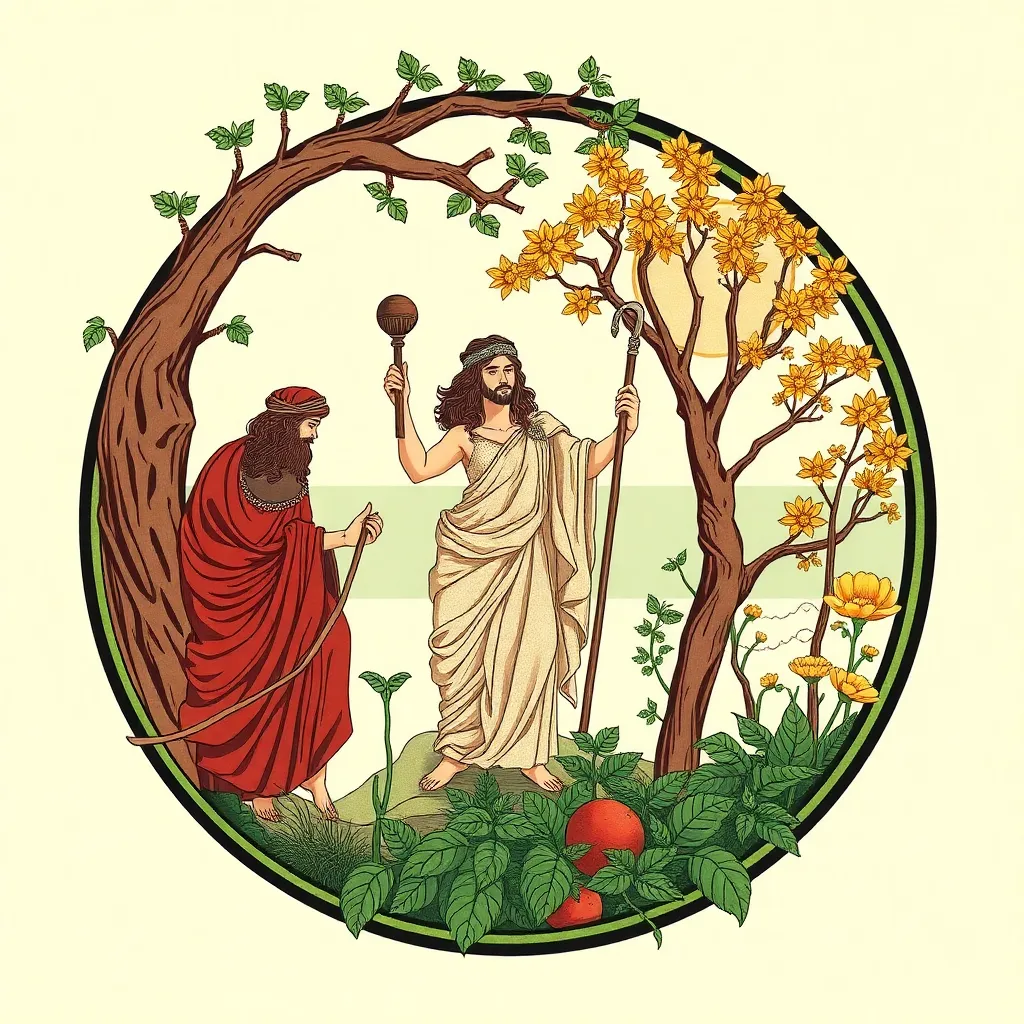Demeter and the Seasons: How Myths Explain Agricultural Practices
I. Introduction
Demeter, the Greek goddess of the harvest and agriculture, holds a significant place in Greek mythology. She symbolizes the nurturing aspect of nature and the cycle of life through her connection with the earth’s fertility. Ancient Greek societies were heavily reliant on agriculture, making Demeter’s influence paramount in their cultural practices and beliefs.
Agricultural practices were not just a means of survival; they were deeply intertwined with the seasons and the myths surrounding them. This article aims to explore the connection between Demeter and the seasonal changes that govern agricultural activities, shedding light on how these ancient narratives helped shape farming practices and societal rituals.
II. The Myth of Demeter and Persephone
The myth of Demeter and her daughter Persephone is at the heart of understanding the seasonal cycles in agriculture. According to the myth, Persephone was abducted by Hades, the god of the Underworld, which plunged Demeter into deep sorrow. In her grief, she neglected the earth, leading to barren fields and a halt in agricultural productivity.
Key themes of this myth include:
- Loss: Demeter’s emotional turmoil reflects the anguish of nature when deprived of its nurturing force.
- Renewal: Persephone’s eventual return from the Underworld symbolizes the return of fertility to the earth.
- The cycle of life: The myth encapsulates the idea of death and rebirth, mirroring the agricultural cycle.
Persephone’s descent into the Underworld and her return each year directly correlate with the changing seasons. Her absence during the winter months represents the barren landscape, while her return in spring heralds the rejuvenation of nature.
III. Agricultural Practices in Ancient Greece
The agricultural practices in ancient Greece were closely linked to the seasonal cycles, which were essential for successful farming. Farmers relied on the changing seasons to guide their planting and harvesting activities. The agricultural calendar was divided into specific periods:
- Spring: Time for planting seeds and nurturing crops.
- Summer: Period of growth and development of crops.
- Autumn: Harvesting time, when the fruits of labor were collected.
- Winter: A time of rest and preparation for the next planting season.
These seasonal activities were often accompanied by rituals and festivals dedicated to Demeter and Persephone. The Thesmophoria, for example, was a festival celebrating fertility and the harvest, emphasizing the relationship between the divine and agricultural success.
IV. Symbolism of the Seasons in the Myth
The myth of Demeter and Persephone serves as a rich tapestry of seasonal symbolism, with each season representing different aspects of agricultural life:
- Spring: Symbolizes renewal and rebirth, marking the start of the planting season when the earth awakens from winter’s slumber.
- Summer: Represents growth and abundance, as crops flourish under the warm sun, providing sustenance for communities.
- Autumn: A time of harvest and gratitude, when bountiful crops are gathered, and thanks are given to the gods for their provision.
- Winter: Signifies dormancy and reflection, a period for the earth to rest and for farmers to plan for the upcoming year.
V. Influence of Demeter on Modern Agricultural Practices
The influence of Demeter is not confined to ancient times; her legacy continues to resonate in modern agricultural practices. Many contemporary farming rituals have roots in ancient traditions, reflecting a deep respect for the land and its cycles.
Some aspects of modern agricultural practices influenced by the myths include:
- Continuing ancient rituals: Farmers may still engage in rituals that honor the earth and seek blessings for a fruitful harvest.
- Foundation for sustainable practices: Myths like Demeter’s emphasize the importance of caring for the land and respecting its cycles, which aligns with modern sustainable agriculture.
- Land stewardship: Modern interpretations of Demeter’s lessons encourage responsible farming practices that prioritize environmental health.
VI. Comparative Myths across Cultures
The themes present in the myth of Demeter and Persephone are echoed in agricultural deities from various cultures around the world. Many societies have myths that explain the relationship between the earth, agriculture, and the changing seasons.
Examples include:
- Inanna: The Sumerian goddess of fertility and agriculture, who also experiences a descent into the Underworld.
- Ceres: The Roman equivalent of Demeter, who oversees agriculture and the fertility of the earth.
- Chac: The Mayan rain god, who is crucial for crop growth and agricultural success.
These myths share a universal theme of death and rebirth, illustrating the cyclical nature of farming and the importance of deities in ensuring agricultural prosperity.
VII. The Role of Myth in Understanding Nature
Myths have historically served as explanations for natural phenomena, providing ancient societies with a framework to understand their environment. They offered narratives that helped people make sense of the seasons, weather patterns, and agricultural cycles.
The educational value of these myths is significant, as they:
- Explain natural phenomena: Myths provide context for events such as droughts, floods, and crop failures.
- Teach agricultural practices: Many myths contain lessons about farming techniques and the importance of timing in agriculture.
- Remain relevant today: These stories continue to inform contemporary discussions on environmental stewardship and sustainability.
VIII. Conclusion
In conclusion, the connection between Demeter and seasonal agricultural practices is profound and multifaceted. The myth of Demeter and Persephone illustrates the cyclical nature of life, loss, and renewal, reflecting the rhythms of agriculture that were essential to ancient Greek society.
The lasting impact of these myths on our relationship with nature invites us to explore and honor these age-old narratives in modern contexts. As we engage with the land and its seasons, we carry forward the lessons of Demeter, fostering a deeper appreciation for the agricultural practices that sustain us.




